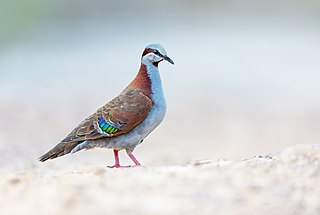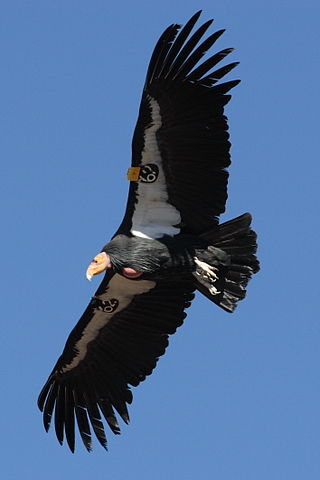
The passenger pigeon or wild pigeon is an extinct species of pigeon that was endemic to North America. Its common name is derived from the French word passager, meaning "passing by", due to the migratory habits of the species. The scientific name also refers to its migratory characteristics. The morphologically similar mourning dove was long thought to be its closest relative, and the two were at times confused, but genetic analysis has shown that the genus Patagioenas is more closely related to it than the Zenaida doves.

The Ischnocera is a large superfamily of lice. They are mostly parasitic on birds, but including a large family parasitic on mammals. The genus Trichophilopterus is also found on mammals (lemurs), but probably belongs to the "avian Ischnocera" and represents a host switch from birds to mammals. It is a chewing louse, which feeds on the feathers and skin debris of birds. Many of the avian Ischnocera have evolved an elongated body shape. This allows them to conceal themselves between the feather shafts and avoid being dislodged during preening or flight.
Coextinction and cothreatened refer to the phenomenon of the loss or decline of a host species resulting in the loss or endangerment of another species that depends on it, potentially leading to cascading effects across trophic levels. The term was originated by the authors Stork and Lyal (1993) and was originally used to explain the extinction of parasitic insects following the loss of their specific hosts. The term is now used to describe the loss of any interacting species, including competition with their counterpart, and specialist herbivores with their food source. Coextinction is especially common when a keystone species goes extinct.
A bird louse is any chewing louse of order Phthiraptera which parasitizes warm-blooded animals, especially birds. Bird lice may feed on feathers, skin, or blood. They have no wings, and their biting mouth parts distinguish them from true lice, which suck blood.

Geophaps is a small genus of doves. Established by George Robert Gray, it contains three extant species. The plumage and distribution suggests that all species within the genus have formed from a common ancestor and that through adaptive radiation they have varied greatly in size, shape and ecology.

Troctomorpha is one of the three major suborders of Psocodea (barklice, booklice, and parasitic lice), alongside Psocomorpha and Trogiomorpha. There are more than 30 families and 5,800 described species in Troctomorpha. The order includes parasitic lice, which are most closely related to the booklice family Liposcelididae.

The Philopteridae are a family of Ischnocera, chewing lice. They are parasitic on birds.

The brush bronzewing is a species of bird in the pigeon family, Columbidae. It is endemic to Australia, with two biogeographically distinct subspecies.

The great cuckoo-dove is a species of bird in the pigeon family, Columbidae. First described by the Dutch zoologist Coenraad Jacob Temminck in 1824, it is found on New Guinea, several surrounding islands, and Wallacea, where it mainly inhabits primary forest and forest edge. It is a large, distinctive pigeon, with a length of 47.5–52.5 cm (18.7–20.7 in) and a weight of 208–305 g (7.3–10.8 oz). In adults, the head, neck, and breast are whitish or blue-grey, the underparts are pale bluish-grey, the upperparts are chestnut-brown, and the outer wings are black. Females differ from males in having more yellowish irises and duller orbital skin. Juveniles are mainly dull grey-brown, with dirty-white throats and bellies.

A large proportion of living species on Earth live a parasitic way of life. Parasites have traditionally been seen as targets of eradication efforts, and they have often been overlooked in conservation efforts. In the case of parasites living in the wild – and thus harmless to humans and domesticated animals – this view is changing. The conservation biology of parasites is an emerging and interdisciplinary field that recognizes the integral role parasites play in ecosystems. Parasites are intricately woven into the fabric of ecological communities, with diverse species occupying a range of ecological niches and displaying complex relationships with their hosts.
Brueelia is a genus of bird lice in the family Philopteridae that infest Passerine (perching) birds. Lice in Brueelia are usually host specific, with more than 85% of described species each found on a single host bird species. Over 300 species of Brueelia have been described, and many more specimens that are presumed to belong to Brueelia are awaiting description and naming.
Saemundssonia is a genus of chewing lice belonging to the family Philopteridae. These lice are parasitic on aquatic birds, especially on members of the order Charadriiformes, but also on Anseriformes, Gruiformes, Pelecaniformes and Procellariiformes. Members of this genus have a broad triangular head bearing a frontal plate with a dark backwards-pointing projection.
Columbicola extinctus, also known as the passenger pigeon chewing louse, is an extant species of phtilopterid louse. It was once believed to have become extinct with its only known host, the passenger pigeon, prior to its rediscovery living on band-tailed pigeons.
Campanulotes is a genus of lice in the disputed, probably paraphyletic, family Philopteridae, the chewing lice, or in the family Goniodidae.
Strigiphilus is a genus of chewing louse in the suborder Ischnocera. It was circumscribed in 1910 by Eric Mjöberg.

Rallicola is a genus of chewing louse. It is an ectoparasite of rails and other birds. It was named by Thomas Harvey Johnston and Launcelot Harrison in 1911. There are two subgenera aside from the nominotypical subgenus: Aptericola, whose species are found on kiwi birds, and Huiacola, a monospecific subgenus consisting of Rallicola extinctus, once found on the huia.

Harrison's rule is an observation in evolutionary biology by Launcelot Harrison which states that in comparisons across closely related species, host and parasite body sizes tend to covary positively.
Naubates is a genus of lice belonging to the family Philopteridae.
Columbicola is a genus of lice belonging to the family Philopteridae.

Nesiotinus is a genus of lice belonging to the family Philopteridae. The genus was first described in 1903 by Vernon Lyman Kellogg, and the type species is Nesiotinus demersus.











